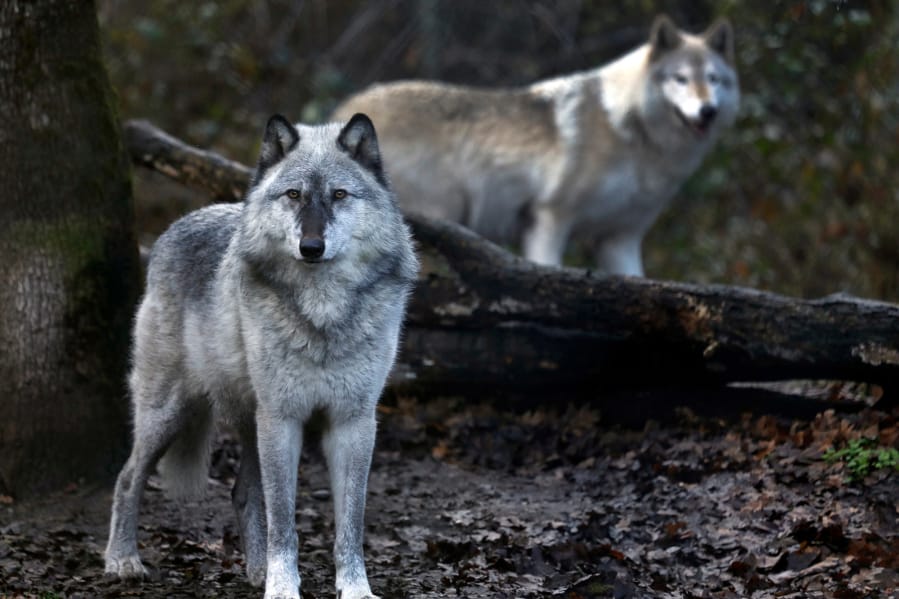LAURIER — When Washington ranchers find that gray wolves have attacked their cattle, they can call the state wildlife agency, which has killed 31 of the protected predators since 2012 under a program intended to save vulnerable livestock.
Many ranches have routinely used state-contracted range riders to ward off wolves, which are listed by Washington as endangered even as they have gradually returned during the last decade after being reintroduced in Idaho.
But not the Diamond M Ranch, which has grazed its cattle on federal land near the U.S.-Canada border in northeast Washington since World War II.
Twenty-six of the 31 eradicated wolves were killed after the Washington Department of Fish & Wildlife deemed that members of their packs had attacked Diamond M livestock.
Environmentalists say the ranch not only fails to take preventive steps to safeguard its herds, but in some cases also brings on attacks by leaving cattle near known wolf dens.
Operators of Diamond M deny that’s the case, but are vociferous about their rights. The issue highlights a clash of cultures between rural Eastern Washington residents and city dwellers west of the Cascade Range who, they and other cattlemen say, don’t know squat about ranching, wildlife and predators.
“Seattle doesn’t ask us what to do with their homeless, and I don’t think we should have to ask Seattle what to do with our wolves,” said Bill McIrvin, 50, a fourth-generation rancher in the family that owns Diamond M.
Wildlife department officials acknowledge that Diamond M has declined offers of state-funded range riders who could help protect cattle. But the agency is not required to mandate preventive measures before wolves are shot or trapped, they say.
Passions over wolves are running so high that in August, agency officials cited threats of violence in canceling a statewide series of 14 public meetings to discuss management once recovery is sufficient for Washington to end the species’ endangered status.
The state’s wolf population had grown to 126 by the end of last year, slowed by the state’s efforts to cull those deemed livestock eaters.
Diamond M itself is a 2,500-acre spread across a mountain pass from the high school Bill McIrvin once attended.
The cattleman denied goading wolves to attack. Rather, he said, his business has lost $1 million since 2008 from the killings of 75 to 100 cattle a year by wolves — many times the number that the state has officially confirmed — and from declines in weight and pregnancy rates among traumatized livestock.
“I don’t feel that we have room for wolves in Washington state,” said McIrvin, who said his family would continue to oppose what they see as a broader agenda of wolf advocates and officials. “If it’s allowed to continue, it’s going to drive the ranching industry out of Washington, which is what a lot of people want. We’re just stubborn, and we won’t leave the range.”
McIrvin views reintroduction of wolves in the West as a plot to end grazing on public land, much as environmentalists used protection of the threatened spotted owl in the 1990s to preserve Northwest forests.
Wolf advocates see Diamond M as an extreme example of ranchers abusing public land privileges, and the wildlife agency as pandering to cattle producers and hunters by slaughtering animals it’s supposed to protect.
“Year after year, Diamond M reportedly loses cattle to wolves while neighboring producers are able to effectively protect their herds,” said Claire Loebs Davis, an attorney for wolf advocates suing the state wildlife department.
Court fights continue, waged by Washington environmentalists and the Center for Biological Diversity, a national conservation organization. The group obtained state wildlife agency records linking Diamond M to the 26 “lethal removals” — a number that neither the agency nor the ranch disputes, except to note that in one case wolves were also blamed for attacking other cattle.
Davis said internal agency documents show that qualified range riders have never patrolled a Diamond M allotment where attacks occurred.
McIrvin contends that “government-sponsored range riders … have never once protected a cow or a calf.”
But range riders counter that they indeed make a difference.
Jan Wright has patrolled on horseback in areas near Diamond M’s federal grazing allotments, safeguarding cattle belonging to five other ranches.
“The ranches that I’ve been riding for in the last few years have not had wolf kills,” Wright said.



